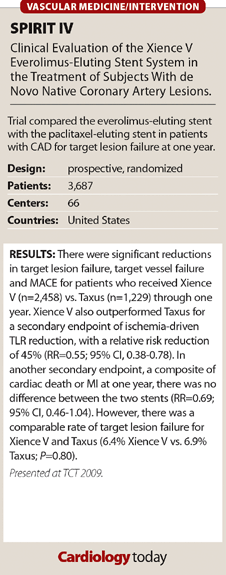SPIRIT IV: Everolimus-eluting stent trumped paclitaxel-eluting stent
First-year data show Xience V bests Taxus, but not in patients with diabetes.
TCT 2009
Gregg W. Stone, MD, of Columbia University Medical Center, New York, presented results showing that the everolimus-eluting stent significantly reduced target lesion failure - the study’s primary endpoint - at one-year follow-up compared with a paclitaxel-eluting stent (everolimus 4.2% vs. paclitaxel 6.8%) in the SPIRIT IV trial.
While overall results favored the everolimus-eluting stent (Xience V, Abbott Vascular), results in patients with diabetes did not.
SPIRIT IV
Stone said there were significant reductions in TLF, target vessel failure and MACE for patients who received the everolimus-eluting stent (n=2,458) vs. paclitaxel-eluting stent (n=1,229) through one year.
The everolimus-eluting stent also outperformed the paclitaxel-eluting stent (Taxus Express, Boston Scientific) for a secondary endpoint of ischemia-driven TLR reduction, with a relative risk reduction of 45% (RR=0.55; 95% CI, 0.38-0.78). In another secondary endpoint, a composite of cardiac death or MI at one year, there was no difference between the two stents (RR=0.69; 95% CI, 0.46-1.04).
SPIRIT IV also included a large number of patients with diabetes (32.2%, n=1,185) compared with SPIRIT III (29%, n=290), but results were not as desirable as some hoped, according to comments during the discussant portion of the presentation.
“This clearly demonstrates that we have a novel, effective … stent platform out to a year and within that, we have greater precision and understanding of all the components,” said Mitchell Krucoff, MD, professor of medicine and cardiology at Duke University Medical Center. “Which of those could be tweaked to have a greater impact in diabetes? It’s important that we continue to wrestle with the science of revascularization in diabetics.”
Stone said there was a comparable rate of TLF for the everolimus-eluting stent and paclitaxel-eluting stent (6.4% Xience V vs. 6.9% Taxus; P=0.80). He said that outcomes in patients with diabetes should be improved through future development of novel drugs and stent design. – by Judith Rusk

For more information:
- Stone GW. Plenary Session IV, Late Breaking Clinical Trials I. Presented at: Transcatheter Cardiovascular Therapeutics 2009; Sept. 21-25, 2009; San Francisco.
